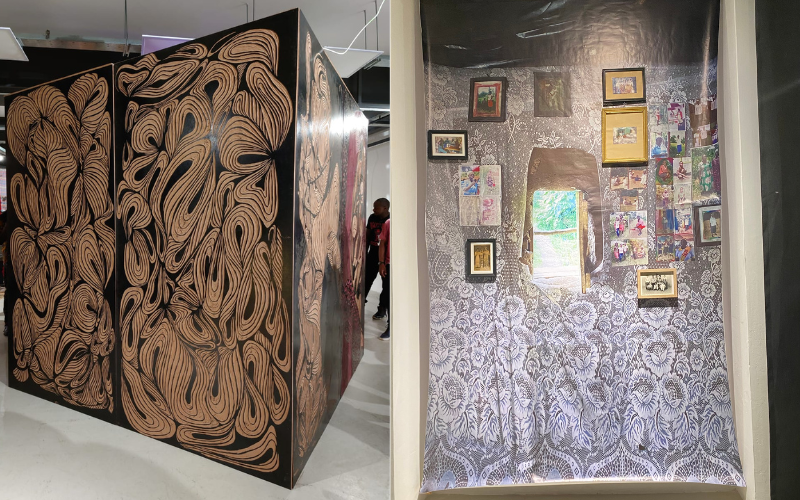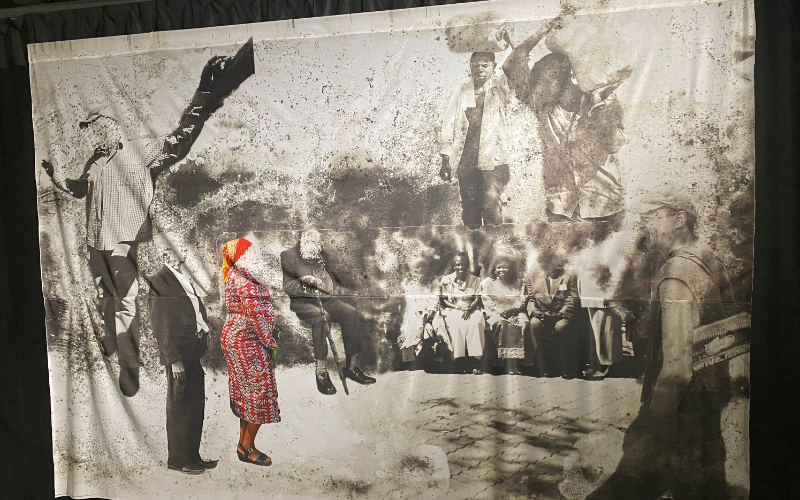The auditorium at Goethe-Institut Nairobi has been transformed into a stunning immersive space, thanks to the imaginative work of five artists who reimagined their crafts, sculpting, photography, wood carving, and animation, into striking life-sized installations.
As you step into the exhibition, you’re greeted by a detailed curatorial statement printed on the wall, offering a preview of what lies ahead. Just nearby is a bed installation glimmering with carefully arranged shards of glass and rocks. This hauntingly beautiful piece, titled The Basin, is by artist Wallace Juma.
Commanding the centre of the auditorium is Light and Voices of Creation, an installation by Sammy Mutinda. The carved wooden box, fitted with lights and sound, invites viewers to step inside and listen to the sounds of nature and human interactions. Mutinda describes his process as symbolic of destruction and renewal, likening wood carving to the shaping of history and personal identity.
“Through carving, I inscribe time, labour, and memory into the surface of the wood,” he explains. “The sounds act as echoes of presence that interact with the carved surfaces. The light moves, shifts, and transforms the carved forms, casting intricate shadows that reveal hidden depths.”

These works are part of The Ties That Bind, an ongoing exhibition that explores themes of identity, memory, labour, and history.
Another standout is WILT by Precious Narotso, which taps into nostalgia and grief through an old television looping animated sketches of childhood TV shows. The installation also reflects on fatherlessness and healing, using personal memory as an emotional anchor.
Photographer Joel Lukhovi presents Now You See I and Now You See II, installations of fading, decaying photographs drawn from personal family albums. Through them, he questions the mortality of photographs and the passage of time.
“I was looking at the life cycle from when photos come to life to when they die,” he says. “Photos can die through destruction, time, loss of relevance, or cultural change, and some can be restored.”
Lukhovi was inspired by rediscovered photographs of his late grandfather, which led him to reflect on memory, identity, and historical erasure.

Covering an entire wall, Fabric of Resilience by Sachy Atieno is a striking installation made from jute sacks, kangas, and plastic. The piece pays tribute to women’s labour and their role in Kenya’s textile industry.
“It explores women’s labour, identity, and representation in Kenya through the lens of the kanga,” Atieno says. “As a child, I was aware of the kanga’s presence without fully understanding its significance. It was a silent witness to the everyday struggles, joys, and triumphs of the women around me.”
She combines traditional textile techniques, tie-dye, batik, screen printing, and more, to honour the painstaking work of women in both domestic and public spheres.
“Working with textiles allows me to move beyond the rigidity of sculpture into a more fluid engagement with materiality,” she adds.
Curated by Niklas Obermann, The Ties That Bind opened on May 3 and runs until May 28. The exhibition features work from the 2024 Sasa Nairobi Fellows, a program by the Goethe-Institut supporting emerging contemporary artists.


